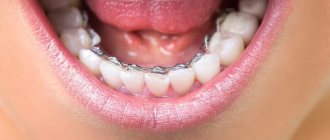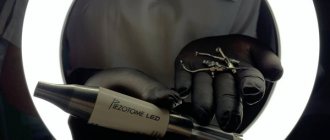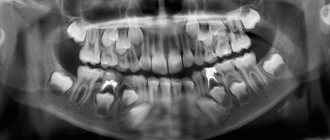27.01.2020
Dear readers, we have prepared an interesting article for you - a review about teeth splinting and answers to related questions. From this material you will learn:
Teeth splinting - what is it? Indications for using the splinting technique; splinting of mobile teeth; what techniques are used; what materials are used; how much does the procedure cost?
WHY ARE TEETH SPLINTED?
We collected the main indications for this procedure and came up with five points:
- With a non-standard direction of tooth growth.
- In case of displacement of teeth in a row.
- For chronic periodontal diseases that cause bleeding.
- In cases where a large amount of deposits accumulate around the tooth root, which can lead to its destruction and tooth loss.
- The presence of deep gum pockets, the appearance of which has led to significant exposure of the roots of the teeth.
Disadvantages of the method
The main disadvantage is that when installing the tire, you will need to carry out special mechanical processing of the enamel.
It is also worth considering that the product cannot be used by all patients. Much depends on the patient himself. He needs to be attentive to oral hygiene and brush his teeth on time. Otherwise, the risk of caries occurring and developing is very high. Hygiene itself will also become more difficult.
When installing a tire, you need to remember the adaptation process. During the first few days, there may be severe tooth sensitivity to sour, hot and cold foods.
SPLINTING FOR PERIODONTITIS, PERIODONTOSIS, DENTAL INJURIES
Periodontal disease is one of the most common problems dentists encounter. Therefore, among the “top” reasons is splinting teeth for periodontitis – an inflammatory disease of periodontal tissue. This disease causes the roots to become exposed. Teeth begin to become loose, which can ultimately lead to tooth loss.
The main task is to strengthen teeth that are starting to become loose. Moreover, it is important to do this at the initial stage. There are several solution options - high-strength fiberglass threads, prostheses, etc.
Often, patients consult a doctor only when the disease is chronic and reaches a moderate or even severe stage. This is expressed not only in unpleasant sensations, but also in the exposure of the subgingival part of the tooth by a quarter or more. Mobility directly depends on how much bone tissue is atrophied in a particular area.
You can check the condition of the bone tissue using a regular x-ray of the jaw area.
Separately, splinting of teeth for periodontal disease, which is not an infectious disease, is considered. There is still no consensus regarding the causes of this pathology. Among the main options:
- Hereditary factor;
- VSD;
- Diabetes;
- Atherosclerosis;
- Hypertonic disease.
The symptoms of periodontal disease and periodontitis are largely similar, although the diseases themselves have very little in common. Tooth mobility occurs only in severe cases of the disease, when the root is exposed by 50% or more.
The materials used include silk, fiberglass and polyethylene threads.
Specialists select them by color so that there is no obvious difference in shade from the tissue of the tooth itself. The choice of technique depends on many nuances: the stage at which the disease occurs, bleeding, general hygiene, the presence of hard deposits on the teeth, tooth mobility, violation of the position of the teeth in the row, the depth of the formed gum pockets.
Another area of work is splinting teeth for injuries. This may include bruises and fractures of the jaw, or other injuries leading to tooth dislocation. The splint allows you to fix it and secure it in such a way as to avoid loosening and subsequent falling out.
Patients often exhibit a symptom such as fan-shaped discrepancy of teeth. To eliminate it, thread-like materials are also used, placed in the sawn furrow and fixed with a filling. The advantage of this method is that the load is evenly distributed between the teeth.
The main causes of loose teeth
Loose teeth in any case is a serious symptom that indicates the development of a pathological process in the body. Experts have identified several main reasons affecting tooth loosening:
- periodontitis;
- periodontal disease;
- gingivitis;
- congenital gum pathologies;
- jaw injuries;
- unbalanced diet;
- tumor formations in the jaw and gums.
The most common cause of this condition is periodontitis, which is inflammation of the periodontal tissue. In this case, the root is exposed and the teeth begin to loosen. Periodontal disease can also often cause loosening; its result is a lack of strength between the tooth and the surrounding tissues. In any case, when one of these diseases is diagnosed, careful and long-term treatment is necessary to help fix the teeth.
On a note! Sometimes a similar condition can be caused by the absence of neighboring teeth when dental implantation and prosthetics were not carried out in time. In this situation, doctors also prescribe splinting and restoration of the lost unit.
HOW IS THE PROCEDURE FOR INSTALLING A SPRINT THREAD?
If a patient requires splinting of the upper jaw teeth, the doctor performs the procedure in several stages:
- An anesthetic injection is given. The drug is selected individually, taking into account sensitivity, allergies, pregnancy and various diseases for which painkillers with adrenaline cannot be used.
- A furrow of the required depth is made in the chewing surfaces.
- A tape is laid in the furrow;
- The cuts are filled with a color-matched filling material. There are now an excellent selection of options that can be cured chemically or cured using a light curing lamp.
For splinting the anterior teeth of the upper row with mobility and/or divergence, the cutting depth is usually 2 mm, the height is similar. This option allows you to eliminate too large interdental spaces.
The doctor determines the general condition of the dentition in order to make a final decision on exactly how many teeth will be in the splint.
If the lateral teeth are splinted, then the cut is made on the chewing surface. The further procedure is carried out according to the same principle.
If a patient is prescribed preventive splinting of the teeth of the lower jaw, then it is performed using a similar technology. But when laying the tape, it catches canines/other teeth that do not have mobility problems.
Before installing a splint, it is important to completely remove soft and hard plaque. Stones on the visible surface of the tooth and on the root itself are one of the main reasons for the development of periodontitis, causing tooth mobility, bleeding gums and other unpleasant symptoms.
Therefore, the doctor must refer the client to hygiene procedures. To prevent problems with enamel, increased sensitivity, etc. after them, remineralization therapy can be prescribed. This includes both the application of special compounds and the use of preparations containing substances that help accelerate the recovery process and saturate the enamel with the necessary compounds.
If the reason for splinting is periodontitis, courses of anti-inflammatory therapy are carried out in parallel. It can be local or general.
In the first case we mean:
- Antiseptic rinses and baths;
- Applications;
- Physiotherapeutic procedures – electrophoresis, laser;
- Correct selection of toothpastes;
General therapy refers to drug treatment.
Usually we are talking about a course of antibiotics in the form of tablets or intramuscular injections.
Therapeutic method
The therapeutic approach involves “tying” the moving elements together with fiberglass tape or armid thread and securing them with filling material. Depulpation is not needed for intervention. Having assessed the condition of the gums, the following types of splinting of the front teeth are used:
- Extracoronary
– the splint is fixed to the enamel surface with dental cement. - Intracoronary
- the splinting element is placed in a small groove on the enamel and secured with a filling composite. Splinting of the upper teeth is performed from the outside, and of the lower teeth from the inside. When laying the thread on the chewing units, a groove is made at the top to ensure better fixation. The tape or thread is applied to the elements that are loose, and to healthy units too. - Occlusal
- splints or retainers act as a splint.
Therapeutic treatment is indicated when all units are present in the row. Splinting teeth with fiberglass tape or armid thread is a gentle method, since it does not involve severe trauma to the coronal part or depulpation.
ABOUT THE MATERIALS
So, let's move on to the important point - the raw materials used when applying a splint to mobile teeth. There are many requirements for it:
- Biocompatibility with natural tissues;
- Hypoallergenic. Not all materials in this regard can be 100% safe for human health.
- Hygiene;
- Ability to withstand mechanical loads.
There are also requirements that are independent of the choice of material. These include:
- Invisibility, allowing you to maintain aesthetics.
- No problems with diction and eating.
- Reliable fixation of mobile teeth. They should not move in any of the possible directions.
- Reliable fixation on the teeth themselves.
It is also very important that the fixing splint does not interfere with brushing teeth and gums and does not injure soft tissues.
Among the most popular options is strengthening teeth with fiberglass tape, as well as its analogues made of polyethylene and silk.
Tire production times are always individual.
In some cases, it is made right in front of you, in others it requires time and work in a dental laboratory.
After the fiberglass thread cures, it turns into a strong element - a beam that holds the teeth together. At the same time, the effect of load distribution acts in such a way that even when biting on just one tooth, the load is divided among all teeth united by the splint. This is important to ensure that the teeth maintain contact with each other.
Many people underestimate the importance of this moment. However, contact greatly influences the rate of bone atrophy, which is observed in many patients
What materials are tires made from?
General requirements are biocompatibility, hypoallergenicity, sufficient strength, and durability.
Fiberglass. Splinting is performed with adhesive tape (lasts 3-4 years). It can be repeated. The material is elastic, does not cause allergies, and is almost invisible. It is quite durable and can be used on any part of the jaw.
Aramid thread. This splinting is called cable-stayed. The strength of the material is several times higher than that of steel, it lasts longer than fiberglass. The splint is biocompatible, does not cause allergies, and is resistant to aggressive environments inside the oral cavity. More often used for premolars and molars: the material has a yellow tint, which can be noticeable.
Metal. Splints are used as part of clasp dentures if there are already gaps in the dentition, and some units are movable. The design restores missing units, the metal elements of the frame ensure the strengthening of the dentition. Constructions can be used only if the patient still has healthy teeth that can serve as supports. Another option for splinting with metal is installing a retainer after orthodontic treatment.
USING ARAMID FIBER
Also very popular is cable splinting of teeth with aramid thread, which has enormous strength. Experts have conducted several studies, during which it turned out that aramid fiber has eight times greater strength than piano steel with similar parameters.
- This technique allows you to achieve excellent aesthetics and correction of the dentition in case of displacements caused by periodontal diseases, injuries and other reasons.
- Aramid fiber is superior in durability to any other thread.
- The material does not enter into chemical reactions with saliva and food, and has excellent biocompatibility.
- Bone tissue stops rapidly atrophying.
- Large gaps between teeth are eliminated. Consequently, the space between them is not clogged and the overall aesthetics are improved.
- The natural load on the dentition is restored.
- You can simultaneously install dentures to replace lost teeth.
Advantages of treatment at the RUTT clinic
The RUTT network of clinics approaches the problem of dental mobility in a comprehensive manner. Treatment is aimed at eliminating the cause of the pathology. In addition to splinting, patients undergo a number of other measures - professional hygiene, therapy of periodontal canals with the Vector device, injections, curettage, physiotherapy, etc. The clinic performs permanent, temporary splinting of the lower teeth.
- Permanent intervention is performed for a period of 12 months or more. The procedure is indicated for mobility of grades 1 and 2, at the first stage of periodontitis, when the jaw bone has not yet been destroyed.
- Temporary fixation of the splint is intended for up to 6 months, if there is a chance of losing loose teeth, but it is small. Also, temporary structures are installed after jaw injuries (fracture, etc.).
The price for splinting teeth in Moscow depends on the technique, materials, and the number of moving elements. The cost of treatment in ROOTT dentistry is formed on a turnkey basis.
HOW TO STRENGTHEN MOVABLE TEETH WITH CROWNS
In modern dental practice, various types of dental splinting are offered, differing in indications and effectiveness. One of them involves the use of metal crowns, or their metal-ceramic and metal-free analogues.
The crowns are connected to each other, thereby eliminating mobility. However, in order to perform the procedure, the nerves are removed from the teeth. Therefore, doctors consider all options before settling on grinding teeth for crowns. Let’s not forget that this method is much more expensive.
Where can splinting of the upper and lower teeth be done?
The DentaGuard dental clinic offers its patients splinting using a wide variety of modern techniques, the selection of which is based on the clinical picture and financial capabilities of the patient.
You can make an appointment with an orthopedic dentist by calling +7 (499) 409-76-60. We are located at Moscow, 4th Vyatsky lane. 16 k.1.
DentaGuard dentistry is open from 09:00 to 21:00 every day except Sundays.
We offer splinting procedures using fiberglass tape, as well as other modern materials, to prevent premature tooth loss as a result of injury or periodontal disease.
REMOVABLE PROSTHETICS AS A METHOD OF SPLINTING
If, in addition to loose teeth, there are also “gaps” formed due to the loss of several teeth in a row, the use of removable dentures is effective. They are used when it is necessary to replace 1–3 teeth in a row. The doctor examines all the nuances regarding the general condition of the dentition, the number of missing teeth, and the presence of bite problems. There is also a dependence of the choice on the age and other individual characteristics of the patient.
There are many materials for making dentures. Some are universal, but expensive. Others are affordable, but are far from ideal in a number of ways, or may cause allergies in some people.
Typically, dental splinting with a removable denture is often chosen as a temporary measure necessary for injuries such as a jaw fracture. During the rehabilitation period, this design provides reliable stability.
Consequences
With periodontitis, the destruction of jaw tissue often occurs rapidly. If the moving units are not strengthened in a timely manner, they will simply fall out. And only implantation will help restore the dentition. The need for the procedure is determined by the doctor, based on the results of the examination and x-ray studies. Reviews confirm the good effectiveness of the intervention; patients quickly adapt and get used to the splint.
Alekperov Roman Borisovich Dentist-orthopedist, doctor of the highest category
What does “constant wearing” mean?
The patient does not have the ability to remove the splint until it needs to be replaced
Alekperov Roman Borisovich Dentist-orthopedist, doctor of the highest category
At what degree of periodontitis is it possible to splint teeth?
At the initial stage
Alekperov Roman Borisovich Dentist-orthopedist, doctor of the highest category
If I am afraid of surgery, is it possible to have anesthesia in advance?
No, only premedication is possible (providing psychological control to the patient by pre-administering medications)
Alekperov Roman Borisovich Dentist-orthopedist, doctor of the highest category
Can there be any complications during the operation?
No complications are possible during splinting
USING CLASS DENTURES TO ELIMINATE TEETH MOBILITY
A technique such as clasp prosthetics can be recommended in cases where other options are excluded for medical reasons, or are not suitable due to anatomical and other features. Eg:
- The patient has a deep bite;
- Signs of bruxism are observed;
- Violation of the natural position of the teeth;
- Periodontal diseases causing bleeding from the gums;
- Displacement of teeth in a row;
- The appearance of periodontal pockets and significant exposure of roots;
- Loss of more than one tooth in a row where there is no supporting tooth for fixation;
- The need for effective redistribution of chewing load.
The design of the clasp prosthesis used for splinting is an arch with several types of fixing elements - clasps and processes, fixed to the teeth and holding those teeth in the row that have become mobile. Crowns are placed on the supporting teeth.
Features and advantages of a splinting clasp prosthesis:
- Does not cause discomfort when wearing;
- Significantly slows down the process of loss of bone and periodontal tissue;
- Does not require long-term adaptation;
- Has compact dimensions;
- Doesn't interfere with eating or talking;
- Does not change the taste of food;
- Has a reliable design
The procedure for manufacturing and installing a tire based on a clasp design is carried out in several stages.
First of all, the doctor examines the condition of the oral cavity, periodontium, jawbone, and takes photographs.
After this, the specialist has data on his hands, on the basis of which a preliminary prosthetic scheme can be determined.
Next, it is necessary to make impressions of both jaws and create a model, with the help of which the frame will subsequently be made. Then they try it on and make an exact adjustment. It is important that the patient does not experience discomfort while wearing the prosthesis.
Splinting teeth: price 2022
How much does teeth splinting cost? The price in Moscow for 2022 in economy class clinics will depend on the number of teeth splinted, as well as the technique...
- Fiberglass splinting of 6 front teeth (with the Ribbond system) - about 6,500 rubles.
- Splinting 3 teeth with fiberglass – from 3500 rubles.
- The cost of splinting teeth with crowns (without the cost of preparing teeth): → with metal ceramics - from 6,000 rubles for 1 crown, → with metal-free ceramics - from 19,000 rubles for 1 crown.
- The cost of a splinting clasp prosthesis is from 25,000 rubles.
POSSIBLE COMPLICATIONS AFTER THE SPLINTING PROCEDURE
Unfortunately, sometimes unpleasant situations arise in which the patient develops complications. There are several options for negative developments:
- In some cases, the groove for the tire is too deep. This leads to opening or damage to the pulp chamber. After some time, the patient develops pulpitis - inflammation of the dental nerve. Typically, in this case, the nerve tissue has to be removed and the tooth filled.
- Because Before the procedure, doctors perform professional cleaning, the thickness of the enamel decreases. This leads to the fact that the patient's teeth may begin to react to cold and hot.
- If the tire becomes deformed during polymerization or overheats, it may break.
- If bacteria remain under the structure, caries may develop, which remains undetected for a long time. Often, patients seek help from a dentist already at the stage of pulpitis development.
- Inflammatory processes and other complications caused by irritation of the mucous membrane, as well as allergic reactions to the material used.
For what reasons does the dentition become mobile?
Doctors identify many reasons why patients need to be splinted. And these include such types of diseases as:
Periodontitis. The main reason for its appearance is poor oral hygiene, as well as the characteristics of the microflora. A strong build-up of tartar can often stimulate the inflammatory process and loosen teeth. In this case, there is a gradual destruction of the fixing ligament, which connects the tooth to other tissues.
- Periodontal disease. It can be quite easily determined by external examination. The gums become whitish, although any negative sensations and pain are practically not observed. Gradually, the volume of the gums decreases, and bare roots become very noticeable. Due to insufficient supporting tissues, the tooth begins to loosen over time. Periodontal disease is often observed in patients with a weakened body due to systemic diseases or long-term treatment.
- Injury. Problems can begin if a jaw fracture has been recorded.
Other categories of patients are also at risk. If you smoke a lot, neglect advice on regular oral hygiene, or suffer from metabolic disorders, you can develop severe tooth mobility. It also manifests itself due to age or poor nutrition.
PATIENTS' REVIEWS ABOUT THE TEETH SPLITTING PROCEDURE
Before praising or criticizing one type of dental splinting, you need to understand the features of the procedure.
For example, when using fiberglass material, the service life does not exceed three years from the date of installation of the tire.
And even then, only with full compliance with all the rules by the doctor and the patient. A polishing procedure is carried out annually.
It is also important to know that in the absence of molars, the load on the front teeth becomes excessive. Therefore, preventive prosthetics of chewing teeth is recommended to restore the natural bite.
As for crowns, they last a long time, and in this regard they are more effective than fiberglass. But to install them, the doctor has to grind the teeth. Cavities can develop under the crown. And if it is necessary to splint a large number of teeth, this is simply impractical and not profitable.
The most reliable and durable option, which allows not only to strengthen existing teeth, but also to replace missing teeth, is the clasp system. However, this method has one significant disadvantage - the price. Not every patient can afford such expenses.
Negative reviews from patients are often associated not with the unprofessionalism of dentists, but with a banal failure to comply with a number of care requirements. In addition, as we wrote above, it is important that when splinting the anterior row you have strong lateral and posterior teeth.
Pros and cons of the splinting technique
Of course, the use of this technique makes it possible to regenerate damaged teeth, helps the body recover and, if necessary, carry out further treatment. Moreover, during the development of periodontitis and periodontal disease, splinting helps distribute the load as needed, increasing it on healthy teeth and decreasing it on damaged teeth. This makes it possible to avoid injury to the gums and quickly restore them.
In addition to significant advantages, splinting also has some disadvantages. Such therapy does not bring results when the disease takes on an advanced form and the inflammatory process progresses; in this case, splints may be ineffective and fall out along with the teeth. Also, patients who do not pay the necessary attention to oral hygiene can increase their problems and acquire pathologies such as pulpitis or the development of caries. If the procedure was performed by an inexperienced specialist, then discomfort for the patient may occur.
Even if the procedure has some disadvantages, this is not a reason not to use the method. To do this, you need to go to a good clinic and see a professional who can carry out all the manipulations clearly and competently. Also, while wearing splints, you should constantly monitor your dental hygiene and thoroughly clean them.
What types of splinting do capital clinics offer?
The most common, and most importantly aesthetic, method is cable-stayed splinting, that is, fastening them together with a thread made of a special material. Typically this wire is made of aramid fiber, which has a number of advantages:
- Bioinertness;
- Hypoallergenic;
- Long service life;
- Aesthetics.
This technique does not cause any discomfort to the patient, including during chewing and articulation.
The essence of the technique is that a small groove no more than 0.5 mm in depth is laid on the inside of the teeth. Then a thread is placed in it, which is fixed with composite materials for reliability. If splinting is carried out not on a permanent basis, but on a temporary basis, then at the end of the course the groove is filled with a composite that matches the color of the patient’s healthy enamel.
If we are talking not about the front teeth, but about the chewing teeth, then the thread is installed on the chewing surface. Despite the fact that the aramid thread has a metallic tint, this will not reduce the aesthetics of the design:
- Firstly, chewing teeth are not visible when smiling;
- Secondly, the composite with which the tire is fixed largely hides it.
Another popular technique is fiberglass splinting. Fiberglass thread or Glassspan also has excellent biocompatibility and is practically invisible on the enamel. The method of attaching it is almost the same as the previous one. Fiberglass tapes have only one drawback - a short service life. After 3 years, the tape must be replaced with a new one.
Dentists also offer splinting with a temporary metal splint in case of a jaw fracture. This is a rather bulky design that looks unattractive. However, the period of wearing it is short - usually the period of treatment for fractures does not exceed six months.
Clasp dentures can also be used to stabilize the dentition. Especially in cases where the patient is missing many teeth.
Features of splinting the anterior teeth of the lower jaw
The procedure requires creating horizontal indentations on the inner surface of the teeth. It is desirable that its height and depth be about 2 mm. A tape is placed in it and a light-curing composite material is applied. The number of teeth involved may vary and is determined depending on the condition of the front teeth. In addition to the most mobile ones, fixed teeth are necessarily involved: most often these are fangs. This approach allows you to remove the load from the movable incisors by transferring some of it to the canines.










